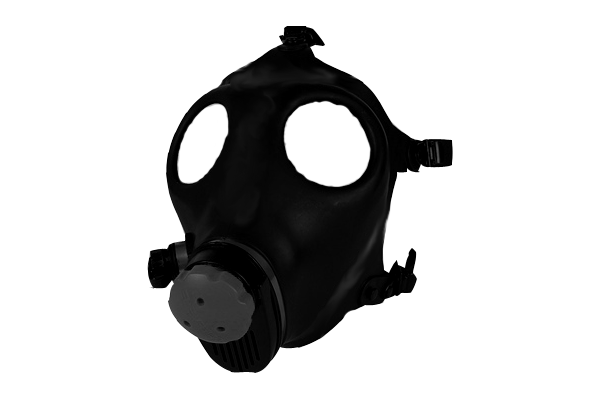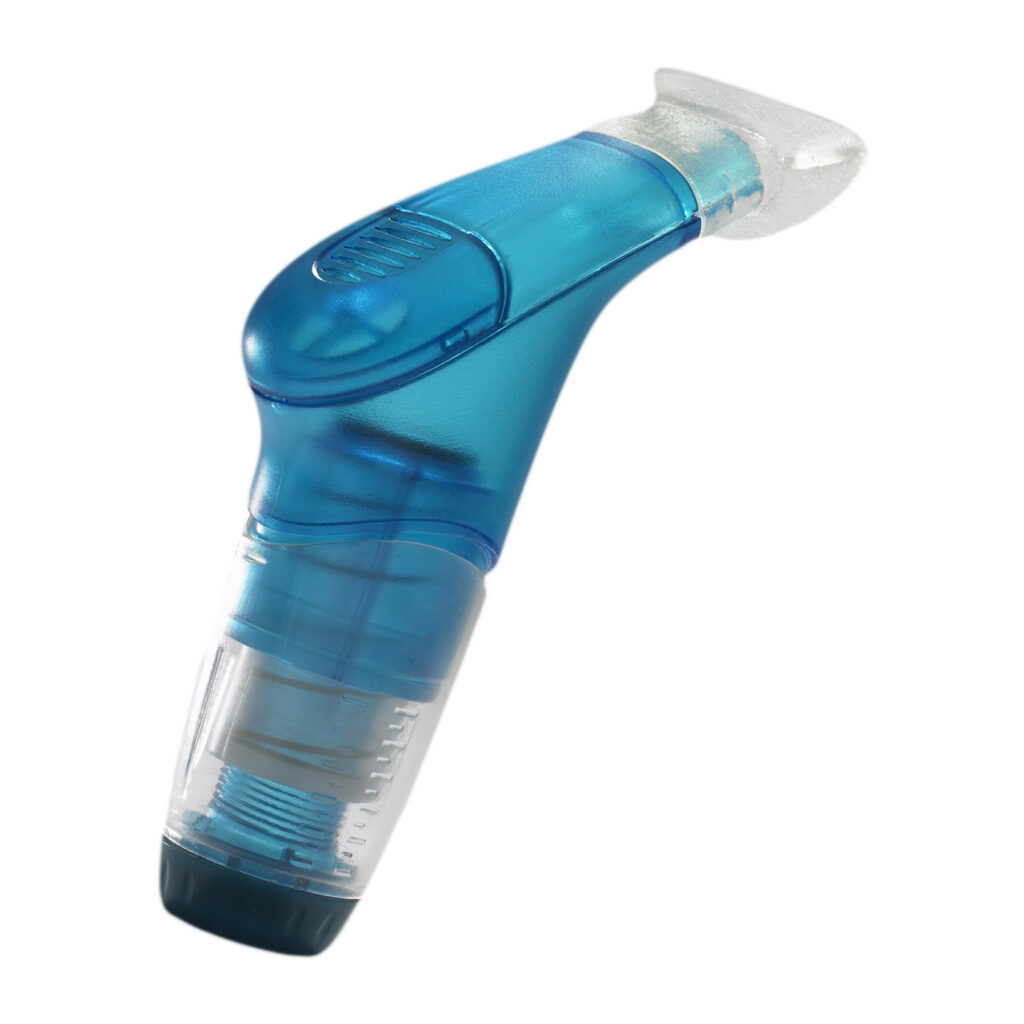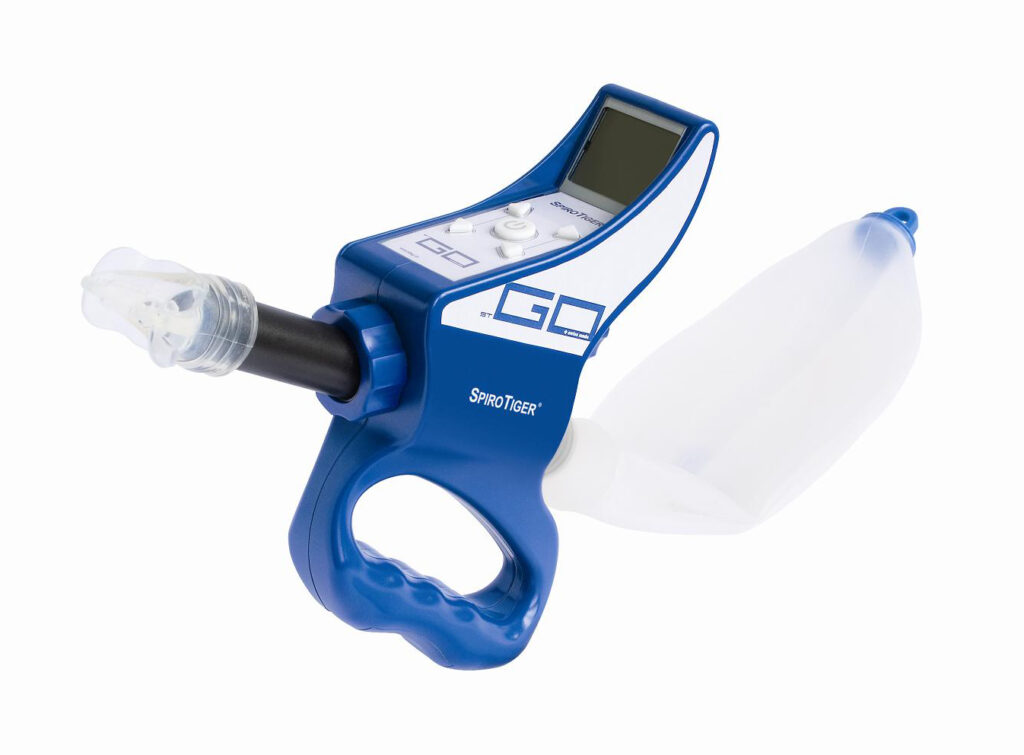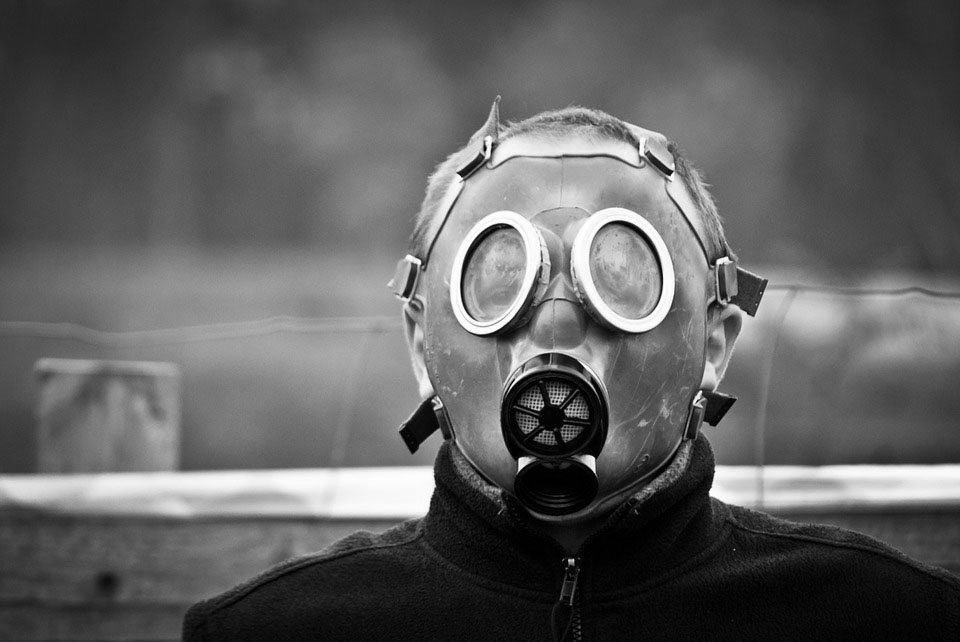Gas masks (respirators) are designed to filter out hazardous airborne contaminants from the air and provide the user with a clean air supply. Gas mask training has been falsely marketed to athletes as an ‘hypoxic training aid’, even though the composition of air filtered through the mask and into the lungs is the same as outside air (i.e. 20.94% O2; 0.03% CO2; 78.94% nitrogen, and other traces). The mask does not lower the percentage of O2 in the air you breathe, nor does it reduce the partial pressure of oxygen in the atmosphere that one would experience at altitude, so it is not a hypoxic training aid.
 Typical training gas mask featuring adjustable flow resistance
Typical training gas mask featuring adjustable flow resistanceMost masks cover at least the nose and mouth, and feature an air filtering canister or a small hole that limits air flow. This has the effect of increasing breathing resistance, particularly when ventilation rates approach and exceed the upper limit of what the respirator was built to accommodate; most commercial respirators can handle air flows of around 85 litres/min. Compare this with the normal air flow of resting humans (6 to 7 l/min) and those heavily exercising (120 to 140 l/min). From this, you can see that a respirator will exert little physiological influence during rest or moderate intensity exercise, but your ventilation rate will likely exceed the maximal air flow capacity of the mask when you are exercising heavily, and this can influence your physiology and performance.
When you exercise with a mask, your respiratory muscles must overcome the resistance imposed by the air filter or small hole in order to maintain adequate O2 and CO2 levels in the lungs, blood and muscles. The human respiratory system easily achieves this by increasing force production in the working muscles and by recruiting other muscles. All of this extra work comes at a cost because the respiratory muscles increase their demand for oxygen and blood. Also, the diaphragm, which is the primary muscle involved in active inspiration, requires a high proportion of blood flow during intense exercise anyway, and it may be susceptible to fatigue, even without the added work associated with wearing a respirator; so when a respirator is worn, the workload placed on the diaphragm is even greater.
‘Gas mask training has been falsely marketed to athletes as an ‘hypoxic training aid’, even though the composition of air filtered through the mask and into the lungs is the same as outside air’
This additional work of breathing will limit exercise performance.1,2 The exact reason is not entirely clear, but is probably due to a competition over oxygen rich blood between respiratory muscles (primarily the diaphragm) and exercising limbs. In this view, a greater percentage of blood flow is diverted to the respiratory muscles and away from the working muscles, which increases limb fatigue.3 So, exercise with a mask can limit exercise performance and diminish the cardiovascular training stimulus.
Wearing a respirator during exercise will also increase breathing discomfort.2 As this is a probable driver of exercise pace, it seems likely that wearing a respirator during self-paced exercise will result in a lower work rate, which will diminish the cardiovascular training stimulus.
It should be stated that wearing a respirator during exercise will probably provide a stimulus to strengthen your respiratory muscles, so it might be considered a form of respiratory muscle training (RMT). But the most established forms of RMT use very different methods to stimulate adaptations in the respiratory muscles, so you should ask yourself ‘am I wearing the mask to improve my cardiovascular endurance, or to train my respiratory muscles’?
In my opinion, it is an inefficient use of your time to wear the mask if your training session objective is to stimulate cardiovascular adaptation; lose the mask and focus on stimulating your cardiovascular system with appropriate sport-specific training loads. If you are wearing the mask to train your respiratory muscles, check that you are following the basic principles of respiratory muscle training.
Respiratory muscle training has been shown to improve exercise performance, and although less fit individuals seem to benefit more from RMT than highly trained athletes, all healthy groups can benefit.4 Interestingly, RMT may be useful for athletes competing in high intensity intermittent sports like MMA. This is supported by a study that showed a reduction in recovery duration between sprints, which was in part attributed to a decreased perception of respiratory effort.5
There are two types of RMT to consider, both of which are completed under resting conditions, without exercise (in contrast to gas mask training, which requires you to wear a mask during exercise). Respiratory muscle strength training (RMST) consists of high force, lower velocity contractions of inspiratory and expiratory muscles. A typical workout might last around 5 minutes and include 30 dynamic inspiratory and expiratory efforts at 50% of you maximal inspiratory/expiratory mouth pressure, once or twice per day, 4-7 days per week, for 6 weeks.4
 A typical device used for RMST is the POWERbreathe (http://www.powerbreathe.com/)
A typical device used for RMST is the POWERbreathe (http://www.powerbreathe.com/)Respiratory muscle endurance training (RMET) consists of low force, higher velocity contractions of inspiratory and expiratory muscles. A typical workout might last around 15 to 30 minutes, and can be undertaken 2 to 5 times per week.4 The most important thing to remember with RMET is to maintain a normal breathing rate.
 A typical device used for RMET is the spirotiger (http://www.spirotiger.com/).
A typical device used for RMET is the spirotiger (http://www.spirotiger.com/).You should be aware of a few things when shopping around for devices; flow resistive training devices, like a gas mask, narrow the airflow path to provide resistance; this is comparable to breathing through a straw. Pressure threshold loading devices require a pre-determined pressure to be obtained before the valve in the training device opens, after which there is no further resistance during that breath. Finally there is (voluntary) isocapnic hyperpnoea (increasing the depth of breathing), which is pretty much an endurance program.
Closing notes
It is quite clear that increasing breathing difficulty acutely i.e. putting the mask on and training, will cause an immediate reduction in your performance. You will not be able to train at the same intensity that you otherwise would without the mask. The principle of specificity suggests that your training should match the demands of your sport, so from this perspective, training with the mask may be ill-advised. One question that remains unanswered however is the influence of repeatedly exercising with increased breathing resistance i.e. wearing the mask for an extended period of weeks. Further research is required to confirm whether any such training adaptation would be imparted to the athlete exercise with and without wearing a mask that increases breathing resistance. Increasing breathing resistance during a training session through the use of a mask might be used as a form of psychological skills training, as it may simulate the stress of ‘gassing-out’, however there is little research to support this approach. For all of these reasons I wouldn’t recommend using a gas mask or training mask if your goal is to build sport-specific cardiovascular endurance. If your goal is to build strength or endurance in your respiratory muscles, you could use the mask, but why not use scientifically tested RMT methods? It is still not clear whether RMST is more or less effective than RMET. Although RMT can be undertaken by athletes of any level (amateur, semi-pro and pro), it should probably be reserved for professional fighters; the rational being that amateur and semi-professional fighters should be dedicating more training time to fundamentals such as skill development, and building a base of muscular strength and cardiovascular endurance. Professional fighters could use RMT, but it must be incorporated in addition to the normal training regime, and not as a replacement for a cardiovascular endurance training session, a strength/power or speed session, or skill development/MMA-specific session.
References

Leave a Reply